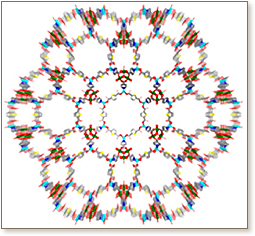

 A two-step crystal engineering strategy has been utilized to synthesize a new and versatile class of metal-organic materials, the first to exhibit 4,6-connected fsb topology. The new fsb networks are constructed from simple and inexpensive nodes (4-connected Zn(CO2)(py)2 tetrahedra; 6-connected Cr(μ3-O)(RCO2)6 trigonal prisms) and linker ligands (isonicotinate and various dicarboxylates). Further, since interpenetration is precluded, they can exhibit extra-large void volumes. These fsb nets are prototypal for what should ultimately become a large family of related structures given the ready availability of functionalized and/or expanded variants of both linker ligands. The fsb nets described herein therefore represent platforms or blueprints for a new family of ultrahigh surface area porous materials.
A two-step crystal engineering strategy has been utilized to synthesize a new and versatile class of metal-organic materials, the first to exhibit 4,6-connected fsb topology. The new fsb networks are constructed from simple and inexpensive nodes (4-connected Zn(CO2)(py)2 tetrahedra; 6-connected Cr(μ3-O)(RCO2)6 trigonal prisms) and linker ligands (isonicotinate and various dicarboxylates). Further, since interpenetration is precluded, they can exhibit extra-large void volumes. These fsb nets are prototypal for what should ultimately become a large family of related structures given the ready availability of functionalized and/or expanded variants of both linker ligands. The fsb nets described herein therefore represent platforms or blueprints for a new family of ultrahigh surface area porous materials.